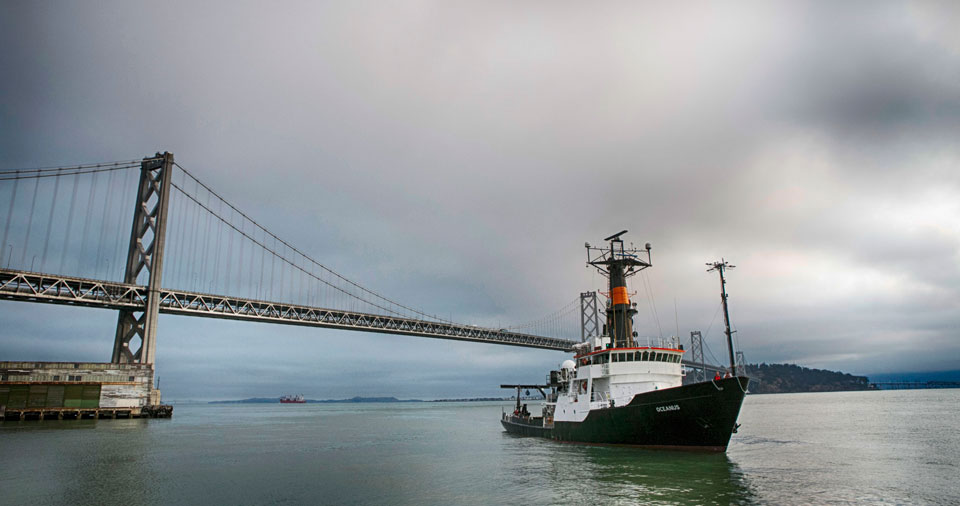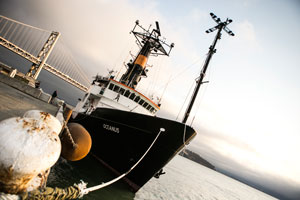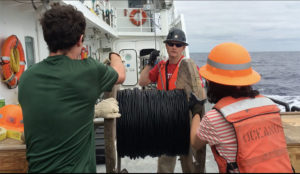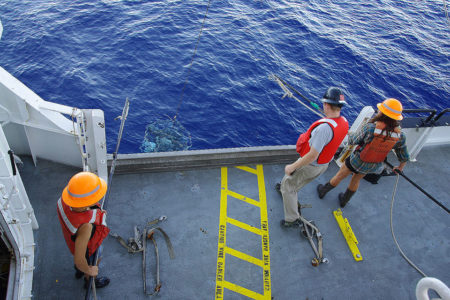 It has been nearly two and a half weeks since I stepped off the research vessel Oceanus, and the phantom swaying motions have already dissipated. It wasn’t a particularly long trip. Just 10 days. But it was enough to provide some insight into the unpredictable, frustrating, time-consuming, exciting and inspiring process of scientific innovation and discovery in the field.
It has been nearly two and a half weeks since I stepped off the research vessel Oceanus, and the phantom swaying motions have already dissipated. It wasn’t a particularly long trip. Just 10 days. But it was enough to provide some insight into the unpredictable, frustrating, time-consuming, exciting and inspiring process of scientific innovation and discovery in the field.
Witnessing part of the journey to getting publication-worthy results and innovative new devices was eye-opening. Not a day went by without some new problem emerging that had to be overcome or puzzled through. When you are 350 miles offshore, you cannot run to your neighborhood hardware store to pick up new screws or a new motor, so problems are tackled on site in less-than-optimal conditions. It’s a situation, I’m sure, that is universal to all manner of field research.
 The Oceanus tied up at Pier 30-32 in San Francisco at 7:20 a.m. on Tuesday, Aug. 23, and we are still getting our land legs back. The time at sea has ended, but the work to compile and analyze the data collected is just beginning.
The Oceanus tied up at Pier 30-32 in San Francisco at 7:20 a.m. on Tuesday, Aug. 23, and we are still getting our land legs back. The time at sea has ended, but the work to compile and analyze the data collected is just beginning. The crew of the Oceanus (Photo: Kelly J. Owen)To get data from the ocean, it takes a village. That village includes a highly trained support crew on the ship to make sure the science team members can perform their research without undue risk to life or limb.
The crew of the Oceanus (Photo: Kelly J. Owen)To get data from the ocean, it takes a village. That village includes a highly trained support crew on the ship to make sure the science team members can perform their research without undue risk to life or limb. We are nearing the end of this 10-day research trip, and as I’m writing, people are bustling around me in the process of deconstructing the labs they set up and packing up their gear. Researchers have made backup copies of the data collected from the various tests conducted, the Carbon Flux Explorers are tucked away in their crates, 700 meters of cable were unspooled from the ship’s winch back onto a reel by hand, and filtering and processing stations – including the “Bubble” – have been taken down.
We are nearing the end of this 10-day research trip, and as I’m writing, people are bustling around me in the process of deconstructing the labs they set up and packing up their gear. Researchers have made backup copies of the data collected from the various tests conducted, the Carbon Flux Explorers are tucked away in their crates, 700 meters of cable were unspooled from the ship’s winch back onto a reel by hand, and filtering and processing stations – including the “Bubble” – have been taken down.  Outside the California Current, the last few experiments are being run aboard the Oceanus at a place Jim Bishop calls “Oceana Incognita.” The nickname came about because the location feels like the middle of nowhere and has not been observed by satellites for the past six weeks.
Outside the California Current, the last few experiments are being run aboard the Oceanus at a place Jim Bishop calls “Oceana Incognita.” The nickname came about because the location feels like the middle of nowhere and has not been observed by satellites for the past six weeks.